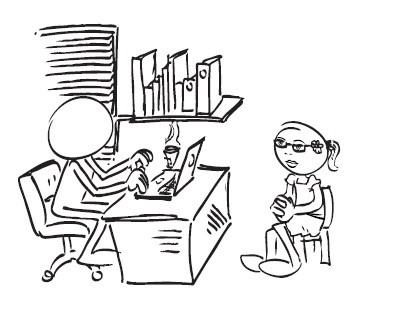Anna has been undergoing treatment for breast cancer, and sits, hopeful and concerned, next to her physician. Dr. Sara Karlsson picks up a tablet and accesses Anna’s most recent radiology report in three taps. Sara reads the report, selects a thumbnail image, and places the tablet between them. Rather than explain what each line of text means, she shows Anna a three-dimensional color-coded CT scan. They both smile. Swiping back to a scan taken on the eve of chemotherapy and radiation therapy, Sara taps to bring up a measurement. Another tap brings them to a graph that shows the reduction in size of Anna’s tumor throughout each stage of treatment. Dr. Karlsson has been explaining what they are looking at, using everyday language that puts Anna at ease. Anna fully understands how treatment is benefitting her condition, and is confident in Dr. Karlsson. She feels in control of her situation. Could Anna and Dr. Karlsson do this today? No, but they could soon—the technology is already here. |
|
RADIOLOGY REPORTS NOW
Today, radiology reports look much the same as they always have. Whether on a computer or a piece of paper, the reports are functionally identical: blocks of text, independent of prior reports, potentially different in both style and content, with no links to images or other data. Radiology reports have failed to keep pace with the advances in technology of the past century. Structured reports carry the promise of standardization and rich reporting, and represent not an idealized future, but the best of what is currently available.
STANDARDIZATION
Structured reports could provide standardization of both information layout and terminology. Doctors would more quickly comprehend reports if information appeared in the same places; a radiologist would more efficiently locate pertinent data from previous reports and record new information using the same template. Standardized report fields could also function as a checklist for the radiologist, minimizing accidental oversight of critical information, and helping to train new radiology professionals. Finally,
structured data is better suited to statistical analysis, and the identification and investigation of trends, than unstructured data.
The Radiological Society of North America (RSNA) has proposed the Radiology Reporting Initiative (Rad Reports), a collection of proposed report templates from 19 industry groups and medical schools—the start of the standardization movement. Radiologists in different countries or hospital groups often use different terms, possibly confusing subsequent unaffiliated users of their reports. In response, the RSNA has created Radlex, in their words “a comprehensive lexicon—a unified language of radiology terms—for standardized indexing and retrieval of radiology information resources.”
RICH REPORTING
The use case of Anna illustrates how rich reporting will revolutionize radiology reports. The ability to directly link from the report to source and other data, whether reports, images, audio files, or alternative presentations of data, will make the radiology report even more valuable to the entire patient-care team. The question is not whether rich reporting elements will become standard in radiology reports—they will—but rather which functionalities will be most desirable, and which existing technologies can be brought together in an efficient and usable format.
ADVANTAGES OF A STREAMLINED PACKAGE
Structured reports can exist independently of image-reading and speech-to-text systems. The health care group will decide whether to employ one or multiple systems, but a single integrated system provides certain advantages: it avoids interface conflicts between separate vendors and allows for greater efficiency and productivity. Consider the smart phone that allows a user to call, text, email, surf the web, and engage an ocean of applications. Similarly, PACS is a natural hub in which to incorporate structured reports, image reading, and speech conversion.
THE RADIOLOGIST IS THE KEY
Structured reporting involves a tension of opposites—the freedom to create reports as desired and the benefits of structured reporting. Hans Lugnegård, Product Manager at Sectra, explains: “I think that a successful implementation would involve the possibility to set up templates from Rad Reports, but also to be able to modify them based on your particular situation—you can go outside the box if you need to.”
Executed poorly, structured reporting will cost the radiologist time. Done well, it will save time and add value. Time saved when looking at previous exams and images to understand patient history will offset time spent creating a report. Addressing the needs of practicing radiologists is critical to determining the proper development of structured reporting. Continues Lugnegård, “If it takes them too long to create the reports, they won’t do it. It has to be efficient.” Accordingly, reports should not be burdened with functionality that radiologists or referring physicians find cumbersome or unnecessary. Practitioners will ultimately determine when they will adopt structured reports, the degree of standardization, and which features to employ.

…BUT EVERYONE BENEFITS
Structured reporting will benefit the health care team and the patients they treat. Radiologists will benefit from greater access to information when creating reports, and the increased value they will provide to everyone else in the patient-care chain; consider the trend for healthcare professionals to work together in clinical teams. Referring physicians will enjoy the abundance of information available to them in a clear and efficient format. Finally, patients will appreciate an enhanced understanding of their own conditions and the superior treatment that structured reports will facilitate—and successful treatment is the ultimate goal.























